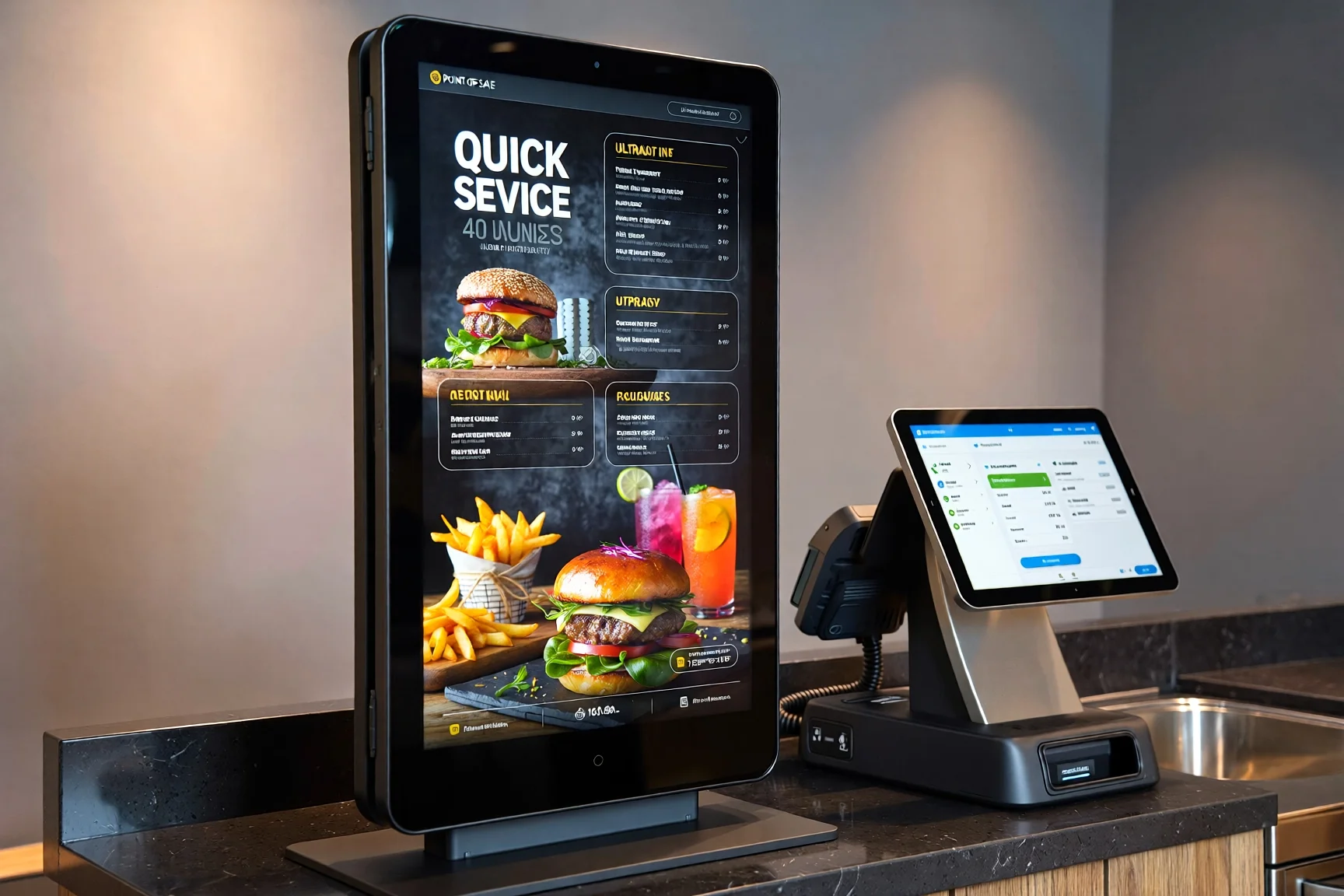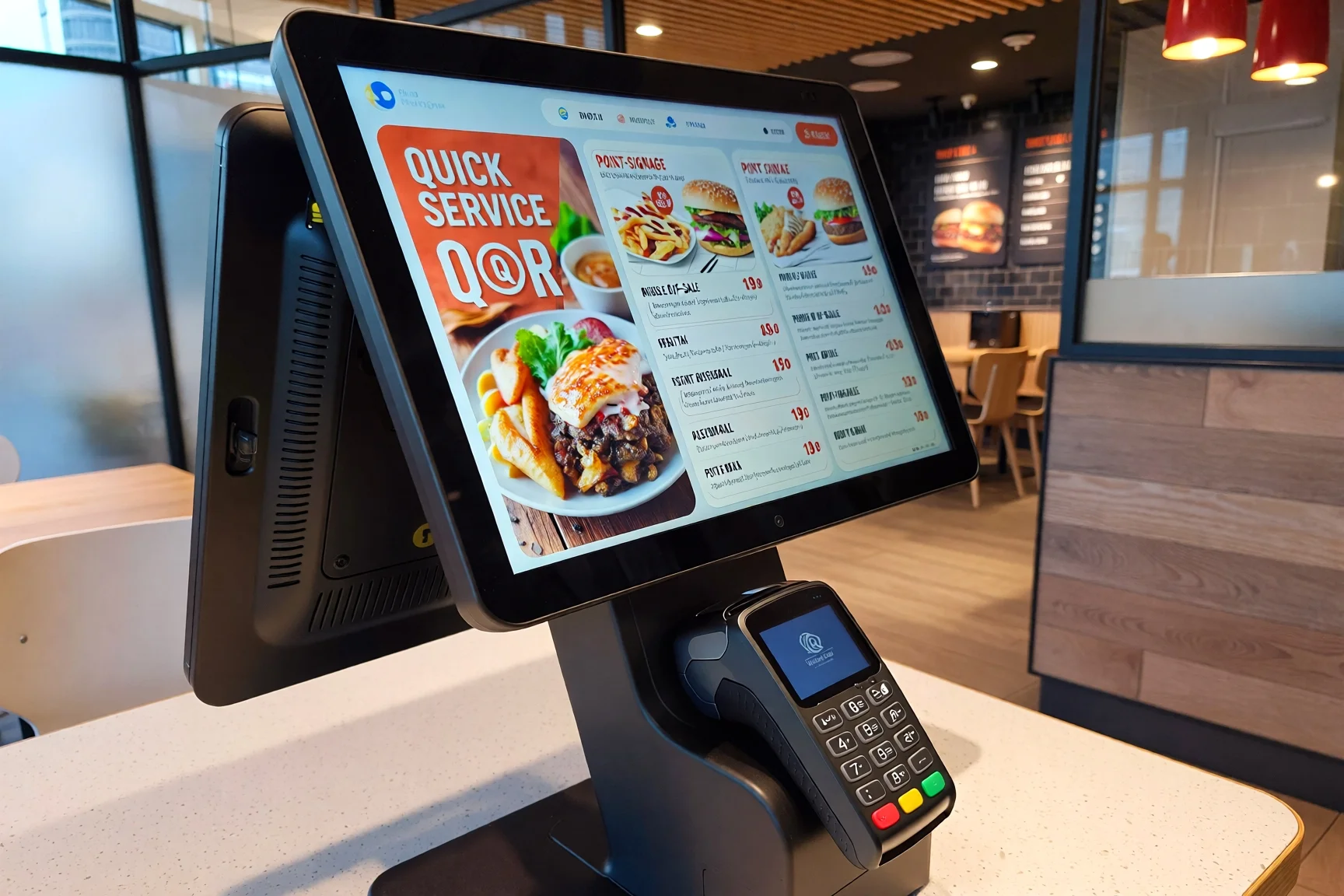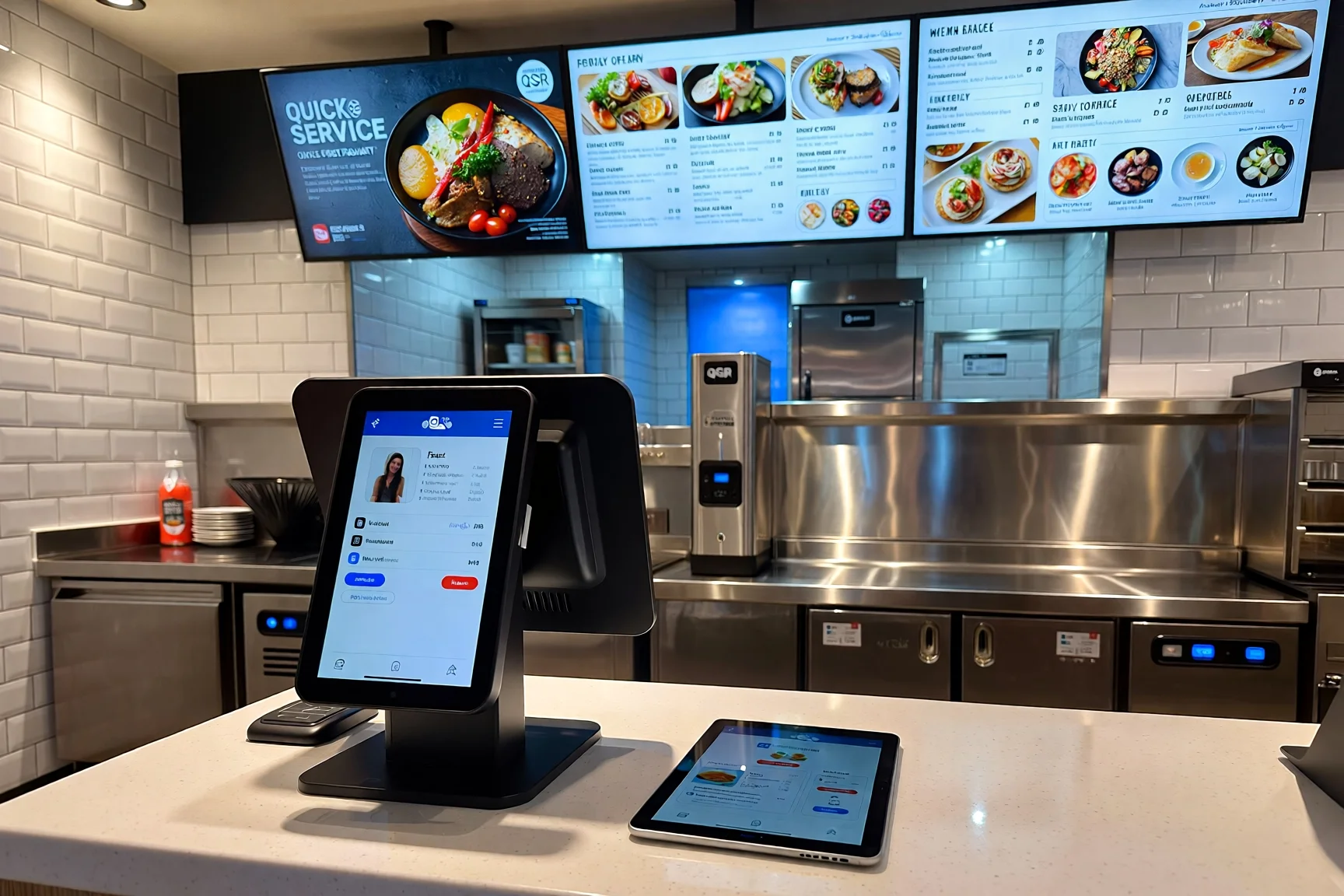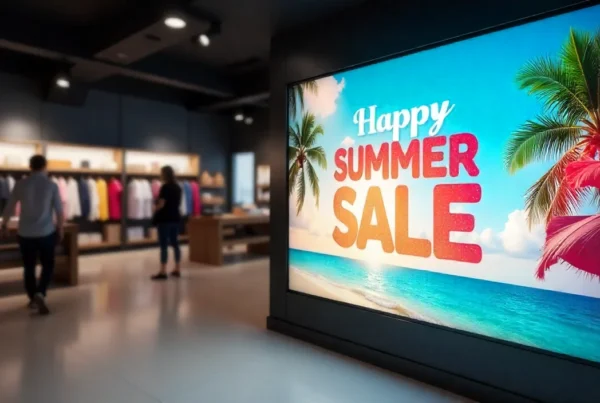Rush hour in a quick service restaurant can feel like controlled chaos: the line keeps growing, orders get mixed up, and new promotions never quite make it to the front counter in time. When that occurs day in and day out, you are not only losing efficiency, you are leaving money on the table.
The key element of a modern quick service operation is its quick service restaurant POS system. It is no longer a cash register but the machine that manages the ordering, payment, inventory, staff processes, and data. In this guide, we will unpack the features of a powerful quick service restaurant POS solution in 2025 and why it has become not a nice-to-have but a competitive need, especially when integrated with tools like QSR Digital Signage.
QSRs that upgrade to modern POS platforms with integrated digital tools often see 10–20% faster service times and noticeable gains in average order value within the first few months.

Understanding the Modern QSR POS System
What is a quick service restaurant POS system?
The POS system of a quick service restaurant is the nervous system of your operation. It integrates all order channels—counter, kiosk, delivery apps—to the kitchen, payment tracking, stock tracking, and performance data in a single location. Managers no longer need separate tools but instead have one platform that keeps the front counter, kitchen, and back office in sync in real time.
With proper POS installation, the orders are tapped by the staff fast, tickets are relayed to the kitchen, and the managers can know exactly what is going on in the business without having to look through spreadsheets.
Many QSRs report up to 30% fewer order errors after moving from basic registers to fully configured POS workflows.
Cloud-Based vs. Traditional Systems: Why the Cloud Wins for QSRs
The older on-premise systems tend to be costly to maintain and hard to upgrade, particularly when they are in use in more than one location. Cloud platforms, on the other hand, allow you to run your restaurants anywhere—modifying prices, altering menus, and reviewing sales from a laptop or mobile phone. The system is always secure and feature-rich due to automatic updates and with no downtimes.
Cloud POS loyalty integrations of quick service restaurants are also much easier through cloud architecture. All this data can be sent to one system, including customer data, rewards, and online orders that will require fewer manual operations and will be more accurate.
Key Features of the Best POS for Quick Service Restaurants
Non-Negotiable Features for Speed and Efficiency
Intuitive Order Interface & Custom Modifiers
Your point of sale must keep up with your line. The interface must be straightforward and visual, where combos, upgrades, and modifiers can be easily searched and used by the staff. In cases where the layout is based on actual ordering patterns, new employees learn more quickly, and the experienced employees are able to work at full speed without errors.
Integrated Kitchen Display Systems (KDS)
The contemporary POS sends orders directly to kitchen display screens rather than paper tickets. The items are categorized by station, time prioritized, and updated automatically whenever changes are made. This eliminates misunderstandings, lessens tipped tickets, and assists the kitchen in maintaining a consistent flow despite a crowded lobby.
Comprehensive Inventory Management
The best POS for quick-service restaurant operations includes built-in inventory tools. Stock levels automatically update as things are sold, and this allows you to see how much you used, minimize waste, and also avoid promising menu items that you are unable to serve. Smart reporting and low-stock alerts simplify and improve the accuracy of ordering.
Scheduling and Employee Management
In-built time clocks and scheduling applications assist you in viewing the relationship between labor and sales. Managers are able to create wiser rosters, keep overtime under control, and staff more individuals based on actual demand rather than estimates.
Operators using POS systems with integrated KDS and inventory features often see 10–20 seconds shaved off average ticket times and smoother peak-hour service.
Sales-Boosting and Marketing Features
Customer Relationship Management (CRM) & Loyalty Programs
Contemporary fast food restaurant POS software must assist you in identifying and rewarding your best clients. The CRM and loyalty modules monitor the visit rate, favorite products, and purchase history, and subsequently automate rewards and incentives. Loyalty programs can be cloud-based so that email, app, and in-store promotions can be based on the same customer data of a quick service restaurant.
Robust Reporting and Analytics
Good reporting is not limited to sales targets per day. It displays the things that make profit, what promotions are effective, how shifts perform, and what performance is by location. Menu adjustments and campaigns are more carefully directed and more effective when they are made based on POS data rather than on gut feeling.

Integration is Everything—Building a Cohesive Tech Stack
Your POS is the Hub—Connect the Spokes
The majority of the QSRs currently use several applications: delivery aggregators, online ordering, loyalty apps, staff scheduling, payment processors, and others. When all of them work in their respective silos, then your team will be retyping orders, reconciling reports, and switching dashboards.
This is solved by treating your POS as the core of a networked technology stack. All the orders in all the channels are processed by a single system; information is automatically transferred, and the manager has a single and trustworthy picture of the business.
Multi-site brands that consolidate tools around a central POS frequently report saving several admin hours per week per location.
The Power Duo: Integrating Your POS with Nento’s QSR Digital Signage
Dynamic Menu Boards
When your POS is connected to the digital signage of the quick service restaurant Nento, changes in the menu cease to be a project. Prices, promotions, and availability can be mirrored in your digital menu boards straight off the POS. Popular items can be obscured or highlighted, and new bundles can be shown as soon as they come into play in the system, eliminating disappointment amongst guests and eliminating staff apologizing.
Upselling and Cross-Selling at the Point of Decision
At the counter, self-service kiosk, or drive-thru, Nento has QSR Digital Signage that displays attractive images that coincide with your POS promotions. Add-ons with high margins, meal upgrades, and limited-time offers can be displayed directly where the customers are deciding what to purchase, and this will not create the additional strain that would otherwise be exerted on the staff.
Streamlining the Order & Pickup Process
Order numbers, customer names, and pickup instructions can also be shown on digital screens connected to your POS in real time. That reduces the perceived wait time, lessens confusion at the counter, and makes the entire experience seem more organized and modern.
Ready to see how Nento’s digital signage can sync with your POS? Book a free demo today and explore a fully integrated QSR experience.
Choosing the Right Quick Service Restaurant POS Solution for 2025
A Buyer’s Checklist
When comparing quick service restaurant POS systems, look beyond a brochure feature list and look at fit. Key questions include:
- Is it online and can be administered in different places easily?
- Is the interface so user-friendly to actual frontline personnel?
- Does it have powerful inventory and labor management tools?
- What are the options of integration, i.e., digital signage, online ordering, loyalty, and accounting?
- What is the overall cost of ownership, such as hardware, support, and payment processing?
The best POS systems for quick service restaurants in 2025 will be more of a platform, not a product: flexible, integration-capable, and able to adapt with your business.

Don’t Forget the Physical Space: The Role of Quick Service Restaurant Interior Design
The cleverest POS will not make up a cluttered or old-fashioned in-store experience. The interior design of modern quick-service restaurants incorporates layout, lighting, and technology that helps the customer navigate easily through the door to the order point and then to pick up.
One of the components of that story is digital signage. The colorful menu boards and in-store screens used by Nento will replace the overcrowded posters with clean and dynamic visuals that will suit your brand. They assist guests in learning about the menu quicker, viewing existing offers with no issues, and feeling like they are at a modern, well-organized location.
QSRs that refreshed both technology and interior visuals—including digital signage—have reported 7–12% higher guest satisfaction scores and better online reviews compared to their pre-upgrade baseline.
Conclusion
One of the strongest investments you can make in your QSR is the right quick service restaurant POS system. It determines the speed of serving the guests and the precision of delivery of orders to the kitchen, as well as your own perception of the performance. However, the actual advantage is achieved in 2025, when your POS is not operating in isolation. It can be fully unlocked when it is combined with such tools as loyalty platforms, delivery channels, and, most of all, QSR digital signage.
The combination of a powerful POS and the dynamic digital signage of Nento results in a quick service atmosphere that is faster, more understandable, and more profitable—one in which your technology does all the heavy lifting and your staff can concentrate on the guest.
Transform your QSR’s operations and customer experience. Let Nento show you how the right digital signage strategy—integrated with your POS—can drive real results. Contact Nento today for a tailored consultation.
Quick Service Restaurant POS System FAQs
What is the difference between a POS system and POS software?
A quick-service restaurant POS system consists of both hardware and software: terminals or tablets, card readers, printers, and the program that will run on them. The software that runs menus, orders, payments, and reports on that hardware is referred to as the quick service restaurant POS software.
Why are cloud-based POS systems better for QSRs?
Cloud-based systems provide real-time information anywhere, automatic upgrades, simpler integration with other cloud-based applications (including the digital signage offered by Nento), and tend to be less expensive to install initially than on-premise systems.
How can digital signage like Nento’s integrate with my POS?
With secure APIs, Nento QSR Digital Signage will be able to dynamically retrieve live data in your POS—updating menus, prices, and availability, and displaying order queues, and even advertising certain items based on time or stock quantities. This generates a coherent, information-based customer experience.
What should I look for in a QSR POS in 2025?
Find a cloud-based platform that has a user-friendly interface, robust inventory management, and employee management and has powerful integration capabilities. The POS solution that is the best for quick service restaurants will not be a standalone solution.
Can digital signage improve my restaurant’s interior design?
Yes. Digital signage is an essential part of the contemporary quick-service restaurant interior design. The screens at Nento make your space more dynamic, vibrant, and transparent, thus making it modern and helping customers see what you offer without needing to read long text.





